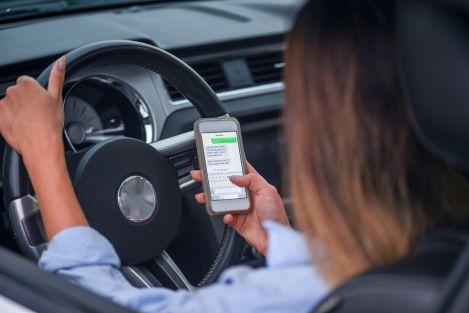
Written by Kayla Jane Barrie Updated on Nov 24, 2025 4 mins read

Are you guilty of texting and driving? In today's fast-paced world, staying connected is more important than ever. With the rise of smartphones, texting has become a ubiquitous form of communication. However, when texting intersects with driving, the consequences can be deadly. Not only does texting and driving endanger lives, but it can also have a significant impact on your insurance premiums.
According to a study conducted in 2022 by CAA South Central Ontario (CAA SCO), 44% of drivers in the province have confessed to being involved in distracted driving, which is a four percent increase compared to the previous year. The study also found that almost two-thirds of those surveyed have witnessed traffic violations or near-collisions due to distracted driving, including texting while driving, which is also an increase of four percent from the previous year.
So, what does it mean for your auto insurance if you are caught? You may be surprised to see how high your rate can increase by focusing on your phone, not the road.
Texting and driving will increase your insurance rates. Texting while driving is a form of distracted driving, which is a leading cause of accidents on the road. This level of distraction significantly increases the risk of accidents, injuries, and even fatalities.
Fines start at $615 for the first offence. Some provinces increase them for subsequent offences. If caught, demerit points will also be added to your licence. If you accumulate enough driving infractions, you may have to get high-risk coverage due to your risky driving behaviour.
Insurance companies base their premiums on various factors, including driving history, age, type of vehicle, and location. One critical factor that insurers consider is the level of risk associated with insuring a particular driver. Engaging in risky behaviours like texting while driving increases your likelihood of being involved in an accident, increasing the risk for companies.
When you're caught texting and driving, it reflects negatively on your driving record and signals to insurers that you pose a higher risk. As a result, you can expect to see an increase in your insurance premiums following a distracted driving conviction. The increase can sometimes be substantial, potentially costing you hundreds or even thousands of dollars over time.
Moreover, a distracted driving conviction may also impact your eligibility for specific discounts or preferred rates offered by insurance companies. Safe driving discounts, which reward drivers with clean records, may no longer be available if you have a texting and driving ticket on your record.
A driver, 32 years old, is behind the wheel of a Volkswagen Golf 1.8 TSI four-door hatchback 2017 in Toronto. They have a G licence, and the individual has been insured since 2006 without interruption. They have maintained a relationship with their current provider for two years. They currently pay $1,291 a year for car insurance in Toronto.
In June of the current year, they received a distracted driving citation, specifically for the "prohibited use of a hand-held device," as outlined in the list of offences. Here is an example of how their rate may increase.
One distracted driving charge: 15% increase = $1,484
Two distracted driving charges within the same year: 27% increase = $1,884
This is only one example of how texting and driving can affect your insurance. Depending on the circumstances of your driving infraction, your rates could increase significantly more.
Many jurisdictions have implemented strict laws and penalties to deter drivers from texting while behind the wheel. These laws vary by region but typically involve fines, licence suspensions, and jail time for repeat offenders. However, the consequences of texting and driving extend beyond legal ramifications to impact your Ontario auto insurance.
Significant convictions related to texting and driving may remain on your driving record for an extended period, and insurers will continue to take them into account 6-8 years post-occurrence, even if they are erased from your driver's abstract, a government document. This underscores one of the numerous reasons why texting and driving should be avoided.
If you use a mobile device while driving in Ontario, the offence will be added to your driving record for two years from the date of the offence. If you are convicted, this conviction will remain on your record for three years from the date of conviction.
Furthermore, if you receive a handheld device ticket in Ontario, your insurer may use it to increase your premiums for up to three years. Demerit points will also be added to your driving record for up to two years.
How can you prevent texting and driving and mitigate its insurance impact? The answer is simple: Put your phone away while driving. Whether it's stowing your phone in the glove compartment, enabling driving mode, or using hands-free technology, find a solution that works for you to eliminate the temptation of texting while driving.
Additionally, consider exploring usage-based insurance (UBI) programs, which use telematics technology to monitor your driving habits, including instances of distracted driving. By demonstrating safe driving behaviours, such as avoiding distractions, you may qualify for discounts on your premium.
Texting and driving is dangerous and carries significant consequences for your rates and overall well-being. By prioritizing safety and practicing responsible driving habits, you can protect yourself, your loved ones, and others on the road from the devastating effects of distracted driving. Remember, no text message is worth risking your life or the lives of others.
| Categories | Auto |
|---|---|
| Tags | Auto Coverage |
Read our insurance blog to get helpful tips, information and news.
Get the facts on Toronto's auto theft problem. We break down the data, reveal the most-stolen vehicles (including the Honda CR-V and Lexus RX 350), and show which neighbourhoods are most affected.
Dive into the world of auto theft with our blog on the most stolen cars in Canada. See the most stolen cars across Canada, including provincial lists for Ontario and Quebec, and learn how high-risk models can affect your car insurance premiums.
Drive safe this winter! Check out these tips for driving in snowy and icy conditions in Ontario. Get other helpful info and FAQs on winter driving.
Drive safer this winter. Learn how the right set of winter tires drastically reduces stopping distance and risk on ice and snow. Get expert tips from your trusted insurance provider.